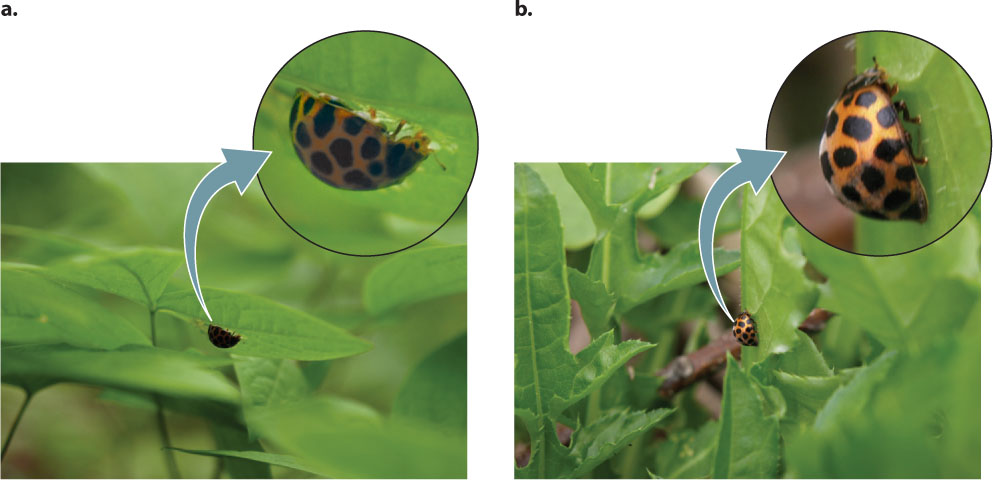22.2 REPRODUCTIVE ISOLATION
Factors that cause reproductive isolation are generally divided into two categories, depending on when they act. Pre-zygotic isolating factors act before the fertilization of an egg, and post-zygotic factors come into play after fertilization. In other words, pre-zygotic factors prevent fertilization from taking place, whereas post-zygotic factors result in the failure of the fertilized egg to develop into a fertile individual.
22.2.1 Pre-zygotic isolating factors occur before egg fertilization.
Most species are reproductively isolated by pre-zygotic isolating factors. Among animals, species are often behaviorally isolated, meaning that individuals only mate with other individuals based on specific courtship rituals, songs, and other kinds of behaviors. Chimpanzees may be our closest relative—and therefore the species we are most likely to confuse with our own—but a chimpanzee of the appropriate sex, however attractive to a chimpanzee of the opposite sex, fails to provoke even the faintest reproductive impulse in a human. In this case, the pre-zygotic reproductive isolation of humans and chimpanzees is behavioral.
Behavior does not play a role in plants, but pre-zygotic factors can still be important in reproductive isolation. Pre-zygotic isolation in plants can take the form of incompatibility between the incoming pollen and the receiving flower so fertilization fails to take place. We see similar forms of isolation between members of marine species, such as abalone, which simply discharge their gametes into the water. In these cases, membrane-associated proteins on the surface of sperm interact specifically with membrane-associated proteins on the surface of eggs of the same species but not with those of different species. These specific interactions ensure that a sperm from one abalone species, Haliotis rufescens, fertilizes only an egg of its own species and not an egg from H. corrugata, a closely related species.
In some animals, especially insects, incompatibility arises earlier in the reproductive process. The genitalia of males of the fruit fly Drosophila melanogaster are configured in such a way that they fit only with the genitalia of females of the same species. Attempts by males of D. melanogaster to copulate with females of another species of fruit fly, D. virilis, are thwarted by mechanical incompatibility.
In all three of these cases—plants, marine invertebrates, and insects—mating with members of one species (and reproductive isolation from other species) is promoted by lock and key systems that require both components, whether physical or biochemical, to match for a successful interaction to take place.
Both plants and animals may also be pre-zygotically isolated in time (temporal separation) and space (ecological separation). For example, closely related plant species may flower at different times, so there is no chance that the pollen of one will come into contact with the flowers of the other. Similarly, members of a nocturnal animal species simply will not encounter members of a closely related species that are active only during the day.
22-6
Closely related species that are separated by vast distances or physical features of the landscape obviously have no opportunity to exchange gametes, but spatial separation may also be more subtle. For example, the two Japanese species of ladybug beetle shown in Fig. 22.5 can be found living side by side in the same field, but they feed on different plants. Because their life cycles are so intimately associated with their host plants (adults even mate on their host plants), these two species never breed with each other. This ecological separation is what causes their pre-zygotic isolation.

22.2.2 Post-zygotic isolating factors occur after egg fertilization.
Post-zygotic isolating factors involve mechanisms that come into play after fertilization of the egg. Typically, they involve some kind of genetic incompatibility. One example, which we saw earlier in Fig. 22.3 and will explore later in the chapter, is the case of two organisms with different numbers of chromosomes.
In some instances, the effect can be extreme. For example, the zygote may fail to develop after fertilization because the two parental genomes are sufficiently different to prevent normal development. In others, the effect is less obvious. Some matings between different species produce perfectly viable adults, as in the case of the horse–donkey hybrid, the mule. As we have seen, though, all is not well with the mule from an evolutionary perspective. The horse and donkey genomes are different enough to cause the mule to be sterile. As a general rule, the more closely related—and therefore genetically similar (Chapter 21)—a pair of species, the less extreme the genetic incompatibility between their genomes.